
Halictidae is the second-largest family of Anthophila bees. Halictid species occur all over the world and are usually dark-colored and often metallic in appearance. Several species are all or partly green and a few are red; a number of them have yellow markings, especially the males, which commonly have yellow faces, a pattern widespread among the various families of bees. The family is distinguished by the arcuate basal vein found on the wing.
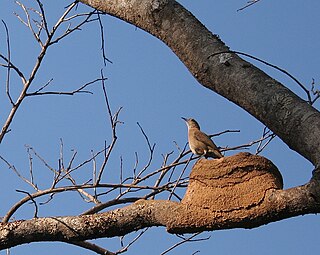
The horneros are members of the genus Furnarius in the family Furnariidae, native to South America.

The white-footed mouse is a rodent native to North America from Ontario, Quebec, Labrador, and the Maritime Provinces to the southwestern United States and Mexico. In the Maritimes, its only location is a disjunct population in southern Nova Scotia. It is also known as the woodmouse, particularly in Texas.
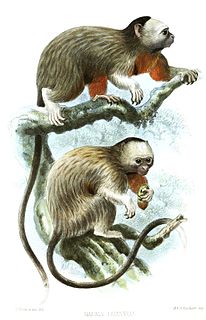
The white-footed tamarin is a tamarin species endemic to Colombia. It is a silvery brown colour with pale streaks and russet underparts, and is very similar in appearance to the cotton-top tamarin, from which it is separated by the Atrato River. It is thought that the two species diverged during the Pleistocene, at a time when a sea occupied the area between their present ranges. This tamarin is an arboreal species, living in small family groups in the canopy. Females give birth to one to three young after a gestation period of about 140 days. This species has a relatively small range and is under threat from destruction and fragmentation of the forest in which it lives and the International Union for Conservation of Nature has assessed its conservation status as "vulnerable".
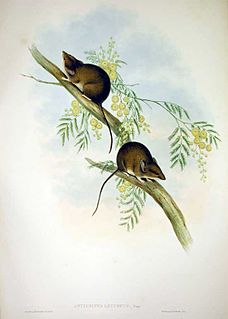
The white-footed dunnart is a marsupial that occurs on Tasmania and mainland Australia. It occurs along the coast and in inner Gippsland and Alpine areas up to 400 metres near Narbethong. The length from snout to tail being 140–200 mm of which head to anus is 70–110 mm and tail 70–90 mm long and with a weight of 19–27 g.
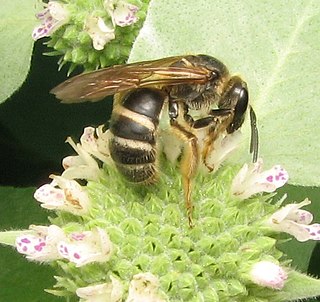
The sweat bee genus Lasioglossum is the largest of all bee genera, containing over 1700 species in numerous subgenera worldwide. They are highly variable in size, coloration, and sculpture; among the more unusual variants, some are cleptoparasites, some are nocturnal, and some are oligolectic. Most Lasioglossum species nest in the ground, but some nest in rotten logs.
The Cape York rat is a species of rodent in the family Muridae. It is found in southern New Guinea, in both Indonesia and Papua New Guinea, and in Cape York Peninsula in Australia.

The pale-legged hornero is a species of bird in the family Furnariidae. It includes the Pacific hornero and the Caribbean hornero, which often are considered separate species.

The white-footed sportive lemur, white-footed weasel lemur, or dry-bush weasel lemur is a species of lemur in the family Lepilemuridae, the sportive lemurs. It is similar in appearance to other lemurs in the family, with a grey back, a pale grey to white ventral side, and a light brown tail. It is a nocturnal animal that moves through the forest using a vertical clinging and leaping technique. It is endemic to Madagascar, inhabiting the southern subtropical or tropical dry shrubland. It is threatened by habitat loss due to agriculture practices and charcoal production.

Lasioglossum zephyrus is a sweat bee of the family Halictidae, found in the U.S. and Canada. It appears in the literature primarily under the misspelling "zephyrum". It is considered a primitively eusocial bee, although it may be facultatively solitary. The species nests in burrows in the soil.
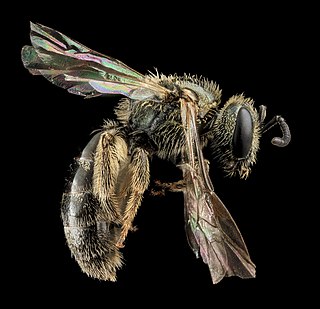
Lasioglossum gotham, commonly known as the Gotham bee, is an extant species of sweat bee native to Eastern and Midwestern United States.

Lasioglossum leucozonium, also known as Lasioglossum similis, is a widespread solitary sweat bee found in North America, Europe, Asia, and parts of northern Africa. While now a common bee in North America, population genetic analysis has shown that it is actually an introduced species in this region. This population was most likely founded by a single female bee.

Lasioglossum sisymbrii is a species of sweat bee in the family Halictidae.

Lasioglossum bruneri, or Bruner's dialictus, is a species of sweat bee in the family Halictidae.

Homalictus is a subgenus of bees in the genus Lasioglossum subfamily Halictinae of the family Halictidae. They are found in Sri Lanka, Southeast Asia, east across the Pacific to the Mariana Islands, Samoa, Fiji and are most prevalent in Australia.
Lasioglossum imitatum is a species of sweat bee in the family Halictidae. It is known as the bristle sweat bee.














